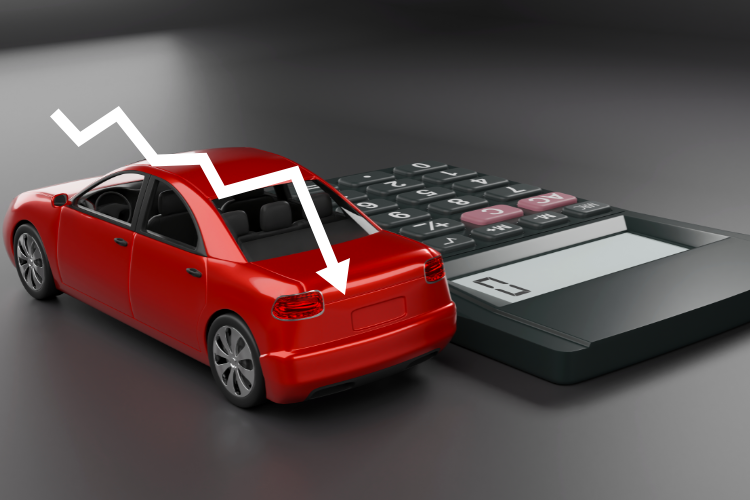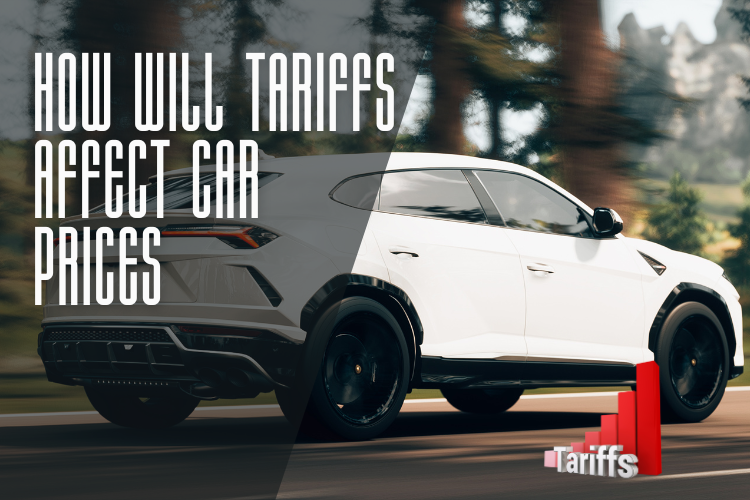It’s no secret that car prices have surged in recent years. Consumers have felt the pinch between the pandemic’s supply chain disruptions, semiconductor shortages, and inflation. With growing discussions about tariffs and prices on imported vehicles and automotive parts, many are left wondering: will car prices go up with tariffs?
In short—yes, tariffs can increase costs for vehicle manufacturers , dealerships, and ultimately, you, the buyer. Whether you’re in the market for a new ride, thinking of buying a used car, or wondering if now is the right time to buy a Tesla, understanding how tariffs play into pricing is more critical than ever.
Rising car prices will be at the top of many Americans’ minds in 2025, and auto tariffs will be a significant reason. According to an industry expert analysis, new and used vehicle prices in the U.S. are expected to spike significantly this year due to the United State’s proposed 25% auto tariffs.
The levies, which apply to imported and American new cars and trucks, are projected to add thousands of dollars to vehicle costs. Used car prices are also expected to climb more than previously forecasted, even amid a slowdown in overall sales.
At Sherpa Auto Transport, we’ve been tracking the shifts in the automotive market to help our customers make smarter car buying and transport decisions. Let’s explore how tariffs are poised to shape the future of car prices in the U.S.—and what that means for your wallet.
Key Takeaways
- Tariffs increase import costs, often passed on to consumers, making new and used cars more expensive.
- Tariffs on new cars and auto parts indirectly impact used car prices as demand for used vehicles rises.
- Parts tariffs raise repair costs, pushing buyers toward newer or more reliable vehicles.
- Auto industry experts warn that prices may not normalize until supply chains stabilize and tariff uncertainties settle.
In This Guide:
- What Are Tariffs?
- How Do Tariffs Affect Car Prices?
- Tariffs and Used Car Prices
- The Hidden Costs of Parts
- When Will Car Prices Come Down?
What Are Tariffs?

Tariffs are taxes imposed by a government on imported goods. When the U.S. imposes a tariff on cars or automotive parts from other countries—like China, Mexico, or the European Union—it makes those imports more expensive. These taxes are paid by the importer (usually the automaker or supplier), not the foreign exporter.
So, why does this matter for car buyers? Companies rarely absorb those costs—they pass them along to consumers. In 2018, the United States implemented a 25% tariff on steel and a 10% tariff on aluminum imports. These materials are crucial for car manufacturing. Automakers faced rising production costs, and vehicle prices increased accordingly.
How Do Tariffs Affect Car Prices?
When tariffs are imposed on cars or car parts, the effects ripple through every automotive industry level — from manufacturing plants to showroom floors. These added taxes on imports translate into higher costs for automakers, dealerships, and, ultimately, consumers. Here’s a closer look at how it all plays out:
1. Manufacturing Costs Rise
Many vehicles — even those assembled in the U.S. — rely on imported parts. Automakers must absorb the higher costs or pass them along to buyers when tariffs are placed on those components. As a result, building a car becomes more expensive, especially when sourcing materials from countries hit by the tariffs.
2. Fewer Vehicle Options

Tariffs can force foreign automakers to scale back U.S. offerings if they can’t keep prices competitive. This reduces consumer choice, especially in categories like fuel-efficient or luxury imports, where overseas brands often dominate.
3. Higher MSRPs at the Dealership
As production costs increase, manufacturers raise the Manufacturer’s Suggested Retail Price (MSRP) to maintain profit margins. This means buyers will likely see more expensive price tags on new and used vehicles — regardless of whether the car is imported or domestically produced.
4. Transportation Costs Grow
Many cars and auto parts cross multiple borders before reaching their final destination. Tariffs can affect not just the goods themselves but the entire supply chain. Longer routes, customs delays, and added shipping fees all contribute to higher final costs.
5. Big Price Jumps for Consumers
According to the Center for Automotive Research, tariffs on imported vehicles could add as much as $6,875 to the price of an imported car. Even U.S.-built cars could see price increases of around $2,750 due to the higher cost of imported parts. These figures highlight tariffs’ far-reaching impact — even on vehicles made in America.
Tariffs and Used Car Prices

So, will tariffs affect used car prices? Absolutely — and perhaps more than many expect. While tariffs generally aim at new imported vehicles and auto parts, the used car market doesn’t exist in a vacuum. It’s susceptible to changes in new vehicle pricing and supply. Here’s a breakdown of how tariffs on new cars and parts can drive up prices for used vehicles:
1. Rising New Car Prices Drive Buyers to the Used Market
As tariffs raise the cost of new vehicles — sometimes by thousands of dollars — budget-conscious buyers are more likely to explore used car options. This increased interest naturally boosts demand in the pre-owned market.
2. Higher Demand Leads To Higher Prices
When more people chase a limited supply of used cars, prices go up. This affects not only late-model used cars but even older vehicles that might have previously gone unnoticed.
3. Maintenance Costs Push People Toward “Newer” Used Cars
Tariffs on imported auto parts also increase the cost of repairs and maintenance. As fixing up an older vehicle becomes more expensive, consumers may purchase newer, low-mileage used cars instead. This added demand can tighten supply further and inflate prices.
4. A Look at Recent Trends
The used car market has already seen massive fluctuations in recent years. In 2022, prices rose over 40% compared to pre-pandemic levels, according to the U.S. Bureau of Labor Statistics. While the market has since cooled, new tariffs could reverse that trend and trigger another price surge — especially if inventory shortages return. If you’re shopping for a used car, you may find better deals by browsing trusted sources.
The Hidden Costs of Parts

Tariffs don’t affect more than just the sticker price of new cars—they also impact the cost of keeping any vehicle on the road. The U.S. imports billions of dollars of auto parts annually, with key components sourced from countries like China, Mexico, Canada, and Germany. The effects cascade across the automotive service industry when tariffs are placed on these parts.
Here’s what that means for everyday drivers:
1. Higher Repair Costs
Whether fixing a fender or replacing a transmission, tariffs on imported parts drive up the cost of repairs — especially for older or imported vehicles that rely heavily on foreign-made components.
2. Longer Wait Times for Parts
Tariffs can disrupt supply chains and create bottlenecks. That means longer wait times at the repair shop while mechanics await parts that used to be delivered quickly and affordably.
3. Higher Insurance Premiums
As repair costs climb, auto insurers raise premiums to cover the added expense. This makes owning and maintaining a vehicle more costly, even if you’re not buying a new car.
These issues don’t just impact individual drivers — dealerships also face challenges. Rising parts costs make it more expensive to recondition used vehicles for resale. Some owners of older cars, discouraged by high repair bills, may opt to sell or trade in their vehicles.
While this boosts used car inventory, it also pushes prices higher for well-maintained pre-owned vehicles, which become even more desirable.
Are you considering the long-term cost of ownership? You might be curious if buying an EV is worth it. Explore our detailed breakdown on buying a Tesla EV.
When Will Car Prices Come Down?

Several factors could help ease car prices in the future:
1. Policy Changes
If the U.S. government chooses to roll back tariffs or reach new trade agreements, the cost of vehicles and parts could decrease. Depending on how soon legislation is passed and enacted, a shift in trade policy could bring relief relatively quickly.
2. Stabilized Supply Chains
Global supply chain disruptions — caused by the pandemic, geopolitical tensions, and shifting trade policies — have increased prices. As these systems stabilize, production and distribution costs may begin to fall.
3. Increased Domestic Production
As automakers expand U.S.-based manufacturing to avoid import taxes, we may see more tariff-free and affordable vehicles. However, scaling domestic production takes time and investment, so it’s not an immediate fix.
In the meantime, consider looking into American-made cars to reduce some of the impacts of tariffs. These vehicles are less likely to be subject to import taxes, making them a smart buy in a tariff-heavy market.
So, how will tariffs affect car prices? The answer is multi-layered but clear: Tariffs create a chain reaction in the automotive industry, affecting everything from production costs to consumer pricing. Whether you’re buying new or used, tariffs have a tangible impact on your bottom line.
As auto tariffs continue to evolve, so will car prices. That’s why staying informed is essential, as is working with experts who understand the industry.
At Sherpa Auto Transport, we’ve helped thousands of customers move vehicles across the U.S. efficiently and affordably. Whether you’re buying from a dealer, a private seller, or even exploring if you can buy a car directly from the manufacturer, we’re here to ensure your car gets home safely—no matter where it comes from or how much it costs.

